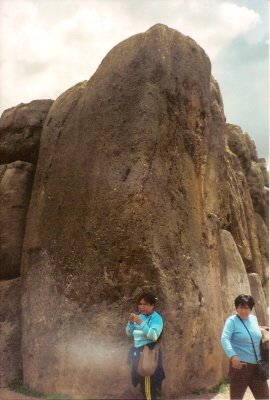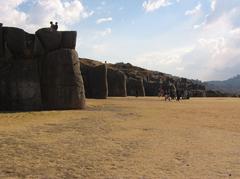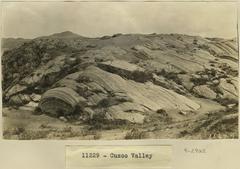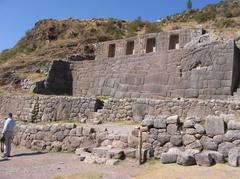
Visiting Hours, Tickets, and Historical Sites in Saqsaywaman, Wanchaq District, Peru
Date: 16/08/2024
Introduction
Saqsaywaman, often spelled Sacsayhuamán, stands as a testament to the architectural genius and cultural prowess of the Inca civilization. Located on the northern outskirts of Cusco, Peru, this citadel is renowned for its impressive stone masonry, which continues to baffle modern engineers and archaeologists. Constructed in the mid-15th century under the reign of Pachacuti and his successors, the citadel’s massive limestone blocks, some weighing over 100 tons, were meticulously quarried and fitted together without the use of mortar (Britannica). The strategic and ceremonial significance of Saqsaywaman is evident in its elevated position, which provided a panoramic view of Cusco and served as a formidable military fortress and a venue for important Inca rituals, such as the Inti Raymi, or Festival of the Sun (Lonely Planet). This guide aims to provide a comprehensive overview of Saqsaywaman, covering its historical background, architectural marvels, visitor information, and practical tips to enhance your visit.
Table of Contents
- [Introduction](#introductionintroduction)
- [Historical Background](#historical-backgroundhistorical-background)
- [Origins and Construction](#origins-and-constructionorigins-and-construction)
- [Strategic and Ceremonial Significance](#strategic-and-ceremonial-significancestrategic-and-ceremonial-significance)
- [Architectural Features](#architectural-featuresarchitectural-features)
- [The Ingenious Stonework](#the-ingenious-stoneworkthe-ingenious-stonework)
- [Zigzag Walls](#zigzag-wallszigzag-walls)
- [The Puma Symbolism](#the-puma-symbolismthe-puma-symbolism)
- [Visitor Information](#visitor-informationvisitor-information)
- [Visiting Hours](#visiting-hoursvisiting-hours)
- [Ticket Prices](#ticket-pricesticket-prices)
- [Practical Tips for Visitors](#practical-tips-for-visitorspractical-tips-for-visitors)
- [Hire a Guide](#hire-a-guidehire-a-guide)
- [Stay Hydrated](#stay-hydratedstay-hydrated)
- [Comfortable Footwear](#comfortable-footwearcomfortable-footwear)
- [The Main Plaza](#the-main-plazathe-main-plaza)
- [Towers and Terraces](#towers-and-terracestowers-and-terraces)
- [The Temple of the Sun](#the-temple-of-the-sunthe-temple-of-the-sun)
- [Water Channels and Reservoirs](#water-channels-and-reservoirswater-channels-and-reservoirs)
- [Earthquake-Resistant Construction](#earthquake-resistant-constructionearthquake-resistant-construction)
- [The Role of Astronomy](#the-role-of-astronomythe-role-of-astronomy)
- [The Construction Process](#the-construction-processthe-construction-process)
- [Preservation and Restoration](#preservation-and-restorationpreservation-and-restoration)
- [Visitor Experience](#visitor-experiencevisitor-experience)
- [FAQ](#faqfaq)
- [What are the visiting hours for Saqsaywaman?](#what-are-the-visiting-hours-for-saqsaywamanwhat-are-the-visiting-hours-for-saqsaywaman)
- [How much are the tickets for Saqsaywaman?](#how-much-are-the-tickets-for-saqsaywamanhow-much-are-the-tickets-for-saqsaywaman)
- [What is the best time to visit Saqsaywaman?](#what-is-the-best-time-to-visit-saqsaywamanwhat-is-the-best-time-to-visit-saqsaywaman)
- [Are guides available at Saqsaywaman?](#are-guides-available-at-saqsaywamanare-guides-available-at-saqsaywaman)
- [Call to Action](#call-to-actioncall-to-action)
- [References](#referencesreferences)
Historical Background
Origins and Construction
Saqsaywaman, often spelled Sacsayhuamán, is a citadel located on the northern outskirts of the city of Cusco, Peru, in the Wanchaq District. This archaeological site is renowned for its impressive stone masonry, which showcases the ingenuity and skill of the Inca civilization. The construction of Saqsaywaman began during the reign of the ninth Inca ruler, Pachacuti, in the mid-15th century and continued under his successors, including Tupac Inca Yupanqui and Huayna Capac.
The site was built using large limestone blocks, some weighing over 100 tons. These stones were quarried from nearby locations and transported to the site using a combination of manpower and rudimentary tools. The precision with which these stones were cut and fitted together without the use of mortar is a testament to the advanced engineering capabilities of the Incas. The walls of Saqsaywaman are constructed in a zigzag pattern, which not only provided structural stability but also symbolized the teeth of a puma, an animal sacred to the Incas.
Strategic and Ceremonial Significance
Saqsaywaman served both strategic and ceremonial purposes. Strategically, it was a military fortress that provided defense for the Inca capital of Cusco. The elevated position of the citadel allowed for a panoramic view of the surrounding area, making it an ideal location for monitoring and defending against potential invaders. The fortress played a crucial role during the Spanish conquest of Peru, particularly in the Battle of Sacsayhuamán in 1536, where the Incas made a valiant but ultimately unsuccessful stand against the Spanish forces.
Ceremonially, Saqsaywaman was a site of great religious and cultural importance. It is believed to have been a venue for various Inca rituals and celebrations, including the Inti Raymi, or Festival of the Sun, which is still celebrated annually in Cusco. The citadel’s design and layout reflect the Inca’s cosmological beliefs, with its three-tiered walls representing the three realms of the Inca world: the Hanan Pacha (upper world), Kay Pacha (earthly world), and Ukhu Pacha (underworld).
Architectural Features
One of the most striking features of Saqsaywaman is its massive stone walls. The largest stones, known as
The Ingenious Stonework
Zigzag Walls
One of the most striking features of Saqsaywaman is its zigzag walls. These walls are composed of three parallel ramparts that stretch for nearly half a mile. The zigzag pattern is not only visually impressive but also served a defensive purpose. The design forced attackers to expose their flanks, making it easier for defenders to repel invasions (Lonely Planet).
The Puma Symbolism
The layout of Saqsaywaman is believed to represent the head of a puma, a sacred animal in Inca cosmology. Cusco, the former capital of the Inca Empire, was designed in the shape of a puma, with Saqsaywaman forming the head and the zigzag walls representing the teeth. This symbolic design underscores the Inca’s deep connection with nature and their belief in the spiritual significance of animals (History Skills).
Visitor Information
Visiting Hours
Saqsaywaman is open to visitors from 7:00 am to 5:30 pm daily. The best time to visit is during the dry season, from April to October, when the weather is more favorable for exploring the ruins.
Ticket Prices
Entrance to the site requires a Cusco Tourist Ticket, which costs 130 soles and includes access to 16 other attractions in the region. Visitors are advised to respect the site’s cultural and historical significance by not touching or climbing on the structures and by disposing of trash properly (My Adventure Across the World).
Practical Tips for Visitors
- Hire a Guide: To fully appreciate the site’s historical and cultural significance, it is recommended to hire a knowledgeable guide (Our Adventure Journal).
- Stay Hydrated: Bring water and sun protection, as the site is at a high altitude.
- Comfortable Footwear: Wear sturdy shoes suitable for walking on uneven terrain.
The Main Plaza
The large, flat parade ground between the zigzag ramparts and the hill is another architectural marvel. This area was likely used for ceremonies and gatherings, including the annual Inti Raymi festival, which celebrates the winter solstice and honors the sun god, Inti. The plaza’s design allowed for large crowds to gather and participate in these important cultural events (Lonely Planet).
Towers and Terraces
Originally, Saqsaywaman featured several towers and terraces that added to its grandeur. The towers, known as Muyucmarca, Paucarmarca, and Sallaqmarca, were strategically placed to provide panoramic views of the surrounding landscape and served both defensive and ceremonial purposes. Although many of these structures were dismantled by the Spanish to build colonial Cusco, their foundations remain, offering a glimpse into the site’s original splendor (Britannica).
The Temple of the Sun
Saqsaywaman also housed important religious buildings, including a temple dedicated to the sun god, Inti. This temple was a focal point for religious activities and ceremonies, emphasizing the site’s spiritual significance. The temple’s location within the fortress highlights the Inca’s practice of integrating religious and military functions within their architectural designs (Leading Peru Travel).
Water Channels and Reservoirs
The Inca engineers incorporated advanced water management systems into Saqsaywaman’s design. The site features a network of water channels and reservoirs that supplied water to the fortress and the city of Cusco. These systems demonstrate the Inca’s expertise in hydraulic engineering and their ability to adapt to the challenging Andean environment (Cusco Peru).
Earthquake-Resistant Construction
One of the most remarkable aspects of Saqsaywaman’s architecture is its earthquake-resistant construction. The precisely cut stones and the absence of mortar allow the walls to move slightly during seismic activity, absorbing the shock and preventing collapse. This ingenious design has enabled the fortress to withstand numerous earthquakes over the centuries, while many more modern structures have crumbled (Britannica).
The Role of Astronomy
The layout of Saqsaywaman also suggests careful planning in accordance with astronomical alignments. The fortress offers a panoramic view of the surrounding landscape, including key landmarks and celestial events that were significant to the Inca. This integration of architecture with the natural world is a hallmark of Inca design and adds another layer of complexity to our understanding of the site (History Skills).
The Construction Process
The construction of Saqsaywaman was a monumental undertaking that spanned several decades. It is believed that more than 20,000 men were involved in the construction, working under the mita system, a form of labor tax that required citizens to contribute their labor to state projects. The construction process involved quarrying, transporting, and precisely fitting the massive stones, showcasing the Inca’s organizational skills and engineering expertise (Cusco Peru).
Preservation and Restoration
Despite the damage inflicted by the Spanish conquest and subsequent looting, much of Saqsaywaman has survived to this day. In 1983, the site was declared a UNESCO World Heritage Site, helping to raise awareness of its historical importance and attract funds for its preservation and restoration. Ongoing archaeological research and conservation efforts continue to uncover new insights into the site’s history and significance (Leading Peru Travel).
Visitor Experience
Today, Saqsaywaman is a popular tourist destination, drawing visitors from around the world who come to marvel at its architectural wonders and learn about the Inca civilization. The site is easily accessible from Cusco, and visitors can explore the ruins, enjoy stunning views of the valley below, and participate in cultural events such as the Inti Raymi festival. To fully appreciate the site’s historical and cultural significance, it is recommended to hire a knowledgeable guide (Our Adventure Journal).
FAQ
What are the visiting hours for Saqsaywaman?
Saqsaywaman is open to visitors from 7:00 am to 5:30 pm daily.
How much are the tickets for Saqsaywaman?
Entrance to the site requires a Cusco Tourist Ticket, which costs 130 soles and includes access to 16 other attractions in the region.
What is the best time to visit Saqsaywaman?
The best time to visit is during the dry season, from April to October, when the weather is more favorable for exploring the ruins.
Are guides available at Saqsaywaman?
Yes, it is recommended to hire a knowledgeable guide to fully appreciate the site’s historical and cultural significance.
Call to Action
To stay updated on the latest travel tips and historical insights, follow us on social media and check out our other related posts. Download our mobile app Audiala for more curated travel experiences.
By understanding and appreciating the architectural marvels of Saqsaywaman, visitors can gain a deeper insight into the ingenuity and creativity of the Inca civilization, making their visit to this remarkable site a truly memorable experience.
References
- Britannica. (n.d.). Sacsayhuamán. Retrieved from https://www.britannica.com/place/Sacsayhuaman
- Lonely Planet. (n.d.). Sacsayhuamán. Retrieved from https://www.lonelyplanet.com/peru/cuzco-and-the-sacred-valley/cuzco/attractions/sacsaywaman/a/poi-sig/1279257/1327082
- History Skills. (n.d.). Sacsayhuamán. Retrieved from https://www.historyskills.com/classroom/year-8/sacsayhuaman/
- My Adventure Across the World. (n.d.). Sacsayhuaman Cusco Ruins Guide. Retrieved from https://myadventuresacrosstheworld.com/sacsayhuaman-cusco-ruins-guide/
- Our Adventure Journal. (n.d.). Sacsayhuaman in Peru. Retrieved from https://ouradventurejournal.com/sacsayhuaman-in-peru/
- Leading Peru Travel. (n.d.). The Magic of Sacsayhuaman: History and Legends. Retrieved from https://leadingperutravel.com/blog/the-magic-of-sacsayhuaman-history-and-legends/
- Cusco Peru. (n.d.). Sacsayhuaman. Retrieved from https://www.cuscoperu.com/en/travel/cusco/archaeological-centers/sacsayhuaman/





